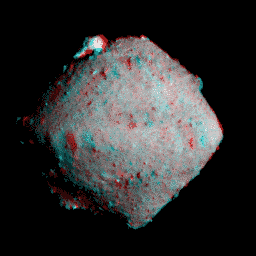Jason Davis • Jul 11, 2018
New goodies from asteroid Ryugu!
Hayabusa2 arrived at asteroid Ryugu back on June 27. Since then, it has been holding at a distance of 20 kilometers while flight controllers back on Earth check out its instruments. At the end of July, the spacecraft will start descending to a height of just 5 kilometers for medium-altitude observations.
The project has been quiet for a couple weeks, but today, JAXA released some new goodies! First, two new global views, the second of which really brings the bright object at the north pole into focus:


And here's a fancy rotation video! Get out your red-and-blue 3-D glasses for this one:

The raw file is a little small, so here's a blown-up version:
Finally, over at unmannedspaceflight.com, Roman Tkachenko used the new data to make an updated shape model of Ryugu.
"It's not perfect, but it's better than nothing," he writes. (Personally, I think it's pretty awesome.)
The Time is Now.
As a Planetary Defender, you’re part of our mission to decrease the risk of Earth being hit by an asteroid or comet.
Donate Today

 Explore Worlds
Explore Worlds Find Life
Find Life Defend Earth
Defend Earth

